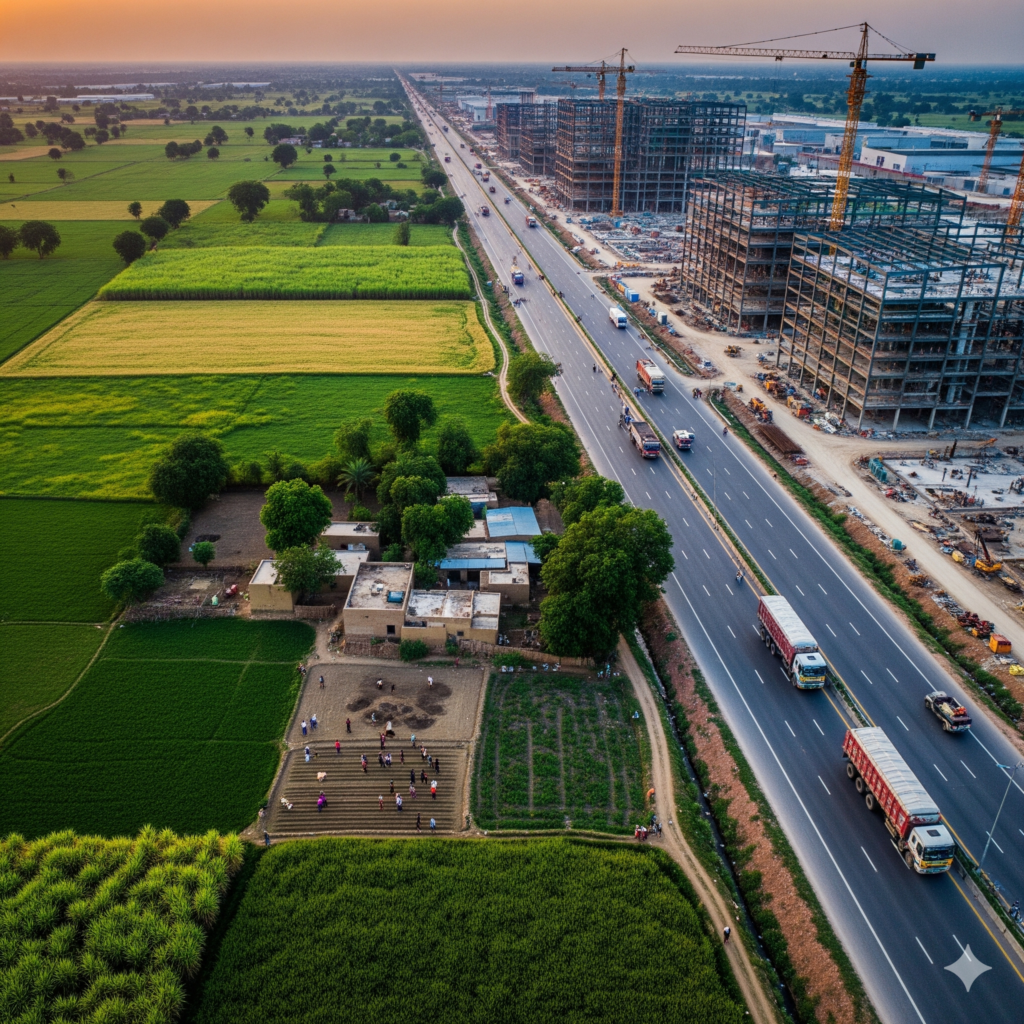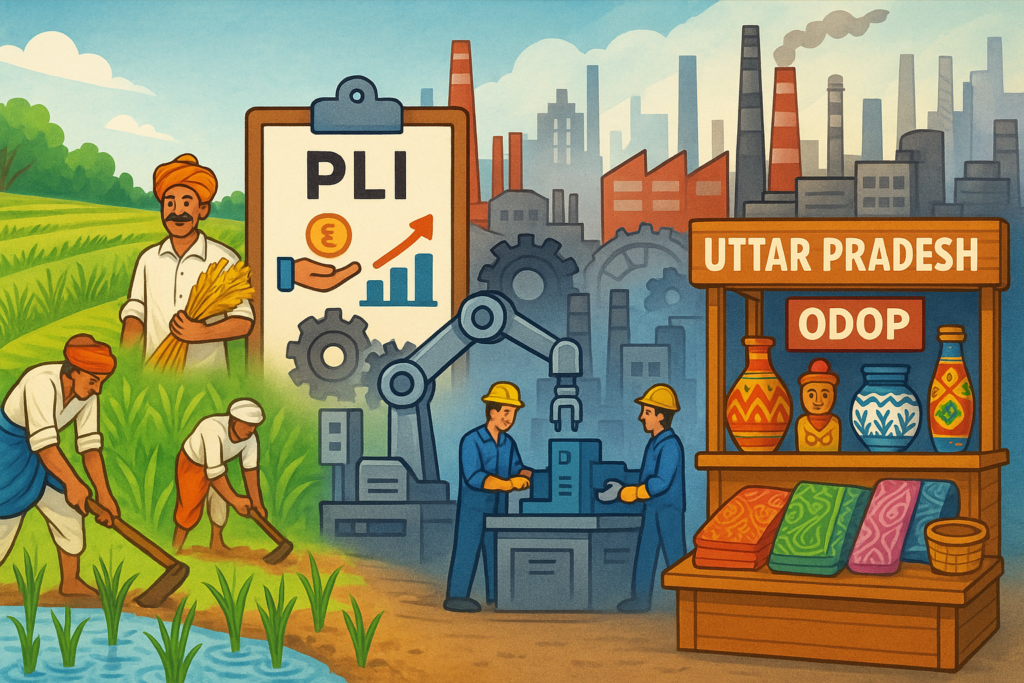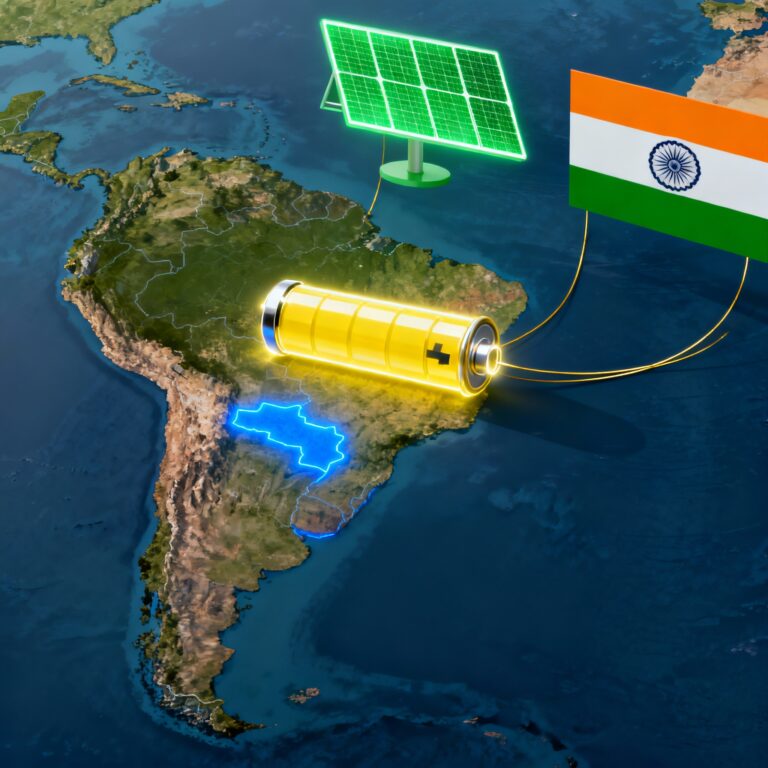
The recent US tariffs on select Asian imports, including solar panels, create significant ripple effects across India’s manufacturing sector. As India’s domestic solar module capacity faces supply glut due to slow bidding and cost pressures, the nation risks losing competitiveness in global markets just as Uttar Pradesh aims for a $1 trillion economy by 2027-28.
Key Highlights
- Solar capacity surge hits wall: India achieved 100 GW solar module manufacturing capacity under ALMM, growing from 2.3 GW in 2014, but faces potential oversupply by 2026 as export opportunities shrink
- US tariff escalation: 50% baseline tariffs on Indian imports with potential anti-dumping duties, severely limiting access to India’s largest export market representing 90% of module exports
- UP’s ambitious leap: Uttar Pradesh targets $1 trillion economy by 2027-28 from current ~$300-400 billion, requiring threefold GSDP expansion through manufacturing and export growth
- Structural vulnerabilities: UP’s agriculture-heavy base (20%+ GSDP) with low per capita income (~₹80,000/year) faces headwinds from rising US protectionism affecting key sectors like leather, textiles, and electronics
- Global trade realignment: US-China tariff escalation to 145-245% forces supply chain restructuring and highlights India’s over-reliance on few export markets, necessitating diversification toward ASEAN and EU
India’s Solar Manufacturing Paradox
Remarkable Capacity Expansion
India’s solar manufacturing sector has achieved extraordinary growth, with module capacity surging from 2.3 GW in 2014 to 100 GW under the ALMM framework by August 2025. The Production Linked Incentive (PLI) scheme drove 25.3 GW of module additions in 2024 alone, supported by government policies ensuring quality standards and domestic procurement preferences.
The ALMM framework, introduced in January 2019, has grown from 21 manufacturers operating 8.2 GW capacity in 2021 to 100 manufacturers across 123 units today. This twelvefold expansion demonstrates the effectiveness of performance-linked incentives that reward actual production rather than mere capacity creation.
Supply Glut Looms Large
Despite impressive capacity growth, concerns about oversupply are mounting. With annual solar additions expected to stabilize at 40-50 GW, the projected 190 GW installed capacity by 2027 could create significant supply-demand imbalance. SBI Capital Markets warns that shrinking export opportunities, particularly after US incentive removals, will exacerbate this glut.
The cell manufacturing gap remains critical, with India’s solar cell capacity at less than 30 GW compared to module capacity. The new ALMM-II mandate for domestically listed cells from August 2025 aims to address this bottleneck but may increase project costs in the interim.

Uttar Pradesh’s Trillion-Dollar Ambition: Promise and Peril
Structural Economic Transformation
Uttar Pradesh has set an ambitious target of achieving a $1 trillion economy by 2027-28, representing a massive leap from its current estimated $300-400 billion GSDP. The state’s economy has already shown impressive growth, with GSDP rising from ₹16.45 lakh crore in 2021-22 to ₹22.58 lakh crore in 2022-23.
However, structural challenges persist. With agriculture contributing over 20% to GSDP and per capita income at approximately ₹80,000 annually, UP faces the classic development dilemma of transitioning from agriculture to manufacturing while maintaining employment.
Strategic Development Framework
The state government has outlined a comprehensive roadmap requiring overall investment of $1.3-1.5 trillion, with private investment expected at ₹93-108 lakh crore compared to public investment of ₹12-16 lakh crore. Key initiatives include:
- PLI scheme utilization for electronics and manufacturing
- Expressway-led logistics development for connectivity
- One District One Product (ODOP) branding for 75 district-specific products
- Public-Private Partnership (PPP) models across multiple sectors
The ODOP scheme has already shown results, with revenue growing from ₹2950.9 crore in FY 2019-20 to ₹4052.4 crore in FY 2020-21, representing 37.3% growth. Districts like Moradabad witnessed 9.8% GSDP growth attributed to increased brassware exports under ODOP.
Global Trade War Escalation: The New Reality
US-China Tariff Spiral
The US-China trade conflict has intensified dramatically, with US tariffs escalating to 34% in April 2025 and threats to reach 245% on Chinese imports. China’s retaliatory measures include 125% tariffs on US goods, creating a cascading effect across global supply chains.
Solar panel tariffs exemplify this escalation, with the US imposing duties up to 3,521% on Southeast Asian solar imports, effectively targeting Chinese companies operating in Cambodia, Malaysia, Thailand, and Vietnam. These measures reflect broader geopolitical decoupling beyond mere trade disputes.
India Caught in Crossfire
India faces collateral damage from this trade war despite not being the primary target. The 50% baseline tariff on Indian imports severely impacts solar panel exports, which represent India’s largest solar export market. Potential anti-dumping duties following the July 2024 US petition could further compress profit margins and limit market access.
Sectoral Impact Analysis: Manufacturing Under Pressure
Solar Industry Vulnerabilities
Indian solar manufacturers face a perfect storm of challenges. US market restrictions coincide with domestic demand stabilization, creating oversupply pressures. Wood Mackenzie analysis suggests India could reach overcapacity as early as 2026, exacerbated by loss of US market access.
The industry’s reliance on Chinese components adds complexity. Despite domestic manufacturing growth, India imported 65.9 GW of cells and modules in 2024, highlighting continued supply chain dependencies. US investigations into Chinese component usage in third countries could affect Indian exports utilizing such inputs.
MSME Sector Stress
Uttar Pradesh’s leather, textiles, and electronics sectors face significant margin pressure from trade disruptions. MSMEs, which form the backbone of UP’s manufacturing, are particularly vulnerable due to:
- Limited financial buffers to absorb tariff costs
- Export dependency on few markets
- Difficulty in rapid market diversification
- Technology and scale constraints for cost competitiveness
The leather cluster in Agra and textile units across UP face direct impact from US market restrictions, threatening employment in these labor-intensive sectors.
Investment Climate and FDI Implications
Renewable Energy Investment Deterrence
Rising trade tensions could deter FDI in solar manufacturing, slowing renewable energy deployment. International investors may reassess market access assumptions, particularly for export-oriented projects. The uncertainty around trade policies makes long-term investment planning challenging.
Technology transfer agreements and joint ventures with Chinese companies face additional scrutiny, potentially limiting knowledge acquisition and innovation partnerships crucial for moving up the value chain.
Infrastructure Development Risks
UP’s massive infrastructure requirements for achieving trillion-dollar economy status depend heavily on sustained investment flows. Trade war uncertainties could delay project approvals and increase financing costs as investors demand higher risk premiums.
Strategic Response Framework: Diversification and Resilience
Trade Partnership Diversification
India must urgently diversify trade relationships beyond the US market. ASEAN countries offer significant opportunities, with existing trade frameworks and growing energy demand. The European Union, with its Green Deal commitments, presents substantial solar market potential.
Regional Comprehensive Economic Partnership (RCEP) participation, despite current absence, could provide alternative market access. Bilateral trade agreements with specific countries offer targeted opportunities for sector-specific exports.
Domestic Consumption Deepening
Strengthening domestic demand becomes crucial for absorbing manufacturing capacity. Storage-led solar adoption and grid modernization can expand internal market size. Rooftop solar acceleration and industrial captive consumption offer demand growth opportunities.
UP’s industrial development must emphasize domestic value chains alongside export orientation. Backward and forward linkages within the state can reduce external dependencies and create resilient industrial clusters.
Technology and Innovation Focus
Moving up the value chain through indigenous technology development reduces dependency vulnerabilities. R&D investments in advanced solar technologies, energy storage, and manufacturing processes can create competitive advantages.
Skill development initiatives aligned with Industry 4.0 requirements ensure workforce readiness for advanced manufacturing. UP’s skill hubs and technical education expansion support this capability building.
Policy Recommendations: Building Resilience
Short-term Measures
Immediate policy interventions should focus on:
- Export financing support for affected sectors
- Market diversification incentives for MSMEs
- Trade facilitation with alternative partners
- Supply chain mapping to identify vulnerabilities
Medium-term Strategy
Structural reforms for sustainable growth include:
- Industrial corridor development with multimodal connectivity
- Technology parks focusing on high-value manufacturing
- Financial inclusion for MSME sector modernization
- Regulatory simplification for business ease
Long-term Vision Alignment
UP’s trillion-dollar economy goal must align with national industrial policy emphasizing:
- Green manufacturing and sustainable practices
- Digital integration across value chains
- Innovation ecosystems linking academia and industry
- Circular economy principles in industrial design
Conclusion
The confluence of US tariffs, domestic oversupply, and ambitious state-level growth targets creates a complex challenge requiring nuanced policy responses. India’s solar manufacturing success demonstrates policy effectiveness but highlights market access vulnerabilities in an increasingly fragmented global economy.
Uttar Pradesh’s trillion-dollar aspiration remains achievable but requires strategic recalibration to emphasize domestic market development, trade diversification, and resilient value chains. The ODOP model’s success and PLI scheme effectiveness provide proven frameworks for scaled implementation.
Success depends on balancing global integration with strategic autonomy, leveraging comparative advantages while building defensive capabilities. The current disruption offers an opportunity for India to accelerate domestic capability building and reduce structural vulnerabilities that over-reliance on few markets creates.
Trade wars may be temporary, but the capabilities built in response can provide lasting competitive advantages. India’s manufacturing future lies in combining scale with sophistication, efficiency with resilience, and global ambition with domestic strength.
📝 Mains Questions
- Evaluate the impact of rising protectionism in advanced economies on India’s solar manufacturing sector. How can states like Uttar Pradesh build resilience while pursuing high-growth ambitions?
- “Trade diversification and domestic industrial policy are key to India’s economic security in a tariff-driven global order.” Discuss in the context of UP’s $1 trillion economy vision.









+ There are no comments
Add yours